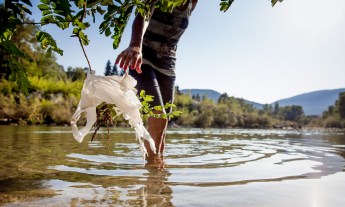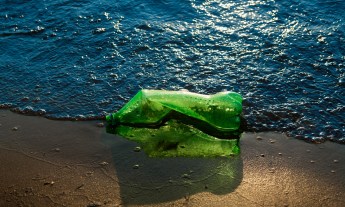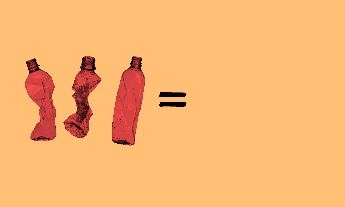
Millions of items are adorned with glitter, from shimmering makeup to sparkling wrapping paper. But the popularity of glitter and the sheer volume used in everyday products is posing a growing threat to our environment and health. Here are five reasons to rethink your glitter habit.
1: Glitter = plastic
Modern glitter originated in 1934 when an American farmer named Henry Ruschmann created a way of cutting mylar and plastic sheets into tiny shapes. He formed Meadowbrook Inventions, which is still one of the main global suppliers of glitter.
The majority of commercial products that contain glitter, whether these are single-use items, such as greeting cards, or more permanent items such as Christmas tree decorations, use inorganic glitter — chiefly plastics such as polyethylene terephthalate (PET) and also polyvinyl chloride (PVC). Glitter is usually layered with other materials like aluminum, which gives it an extra sparkle. Underneath the microscope, it is possible to see the huge variation of glitter shapes and sizes: hexagons, squares, rectangles and even hearts and stars ranging from 6.25 mm to a truly tiny 0.05 mm.
2: Glitter is bad for marine life
Most people understand that microplastics, such as fibers from clothes or microbeads in facial scrubs, are dangerous to sea life. And since glitter particles are purposely manufactured to be of microscopic size (less than 5mm in size), it’s classed as a primary type of microplastic.
The size of [microplastics] means they are easily consumed by small marine organisms, which cannot discriminate between particles of food and plastic.
Glitter can enter seas and oceans from rivers, via wastewater from our homes and run-off from landfill sites. Although many are removed at wastewater treatment plants, a huge amount of microplastics still find their way through to the oceans. The size of these particles means they are easily consumed by small marine organisms, which cannot discriminate between particles of food and plastic.
Microplastic particles also attract inorganic and organic chemicals to adhere to them, including polychlorinated biphenyls (which have been banned since 1979) and toxic heavy metals. A big risk to wildlife comes from the bioaccumulation of these toxins in the food chain.
3: Glitter can last for years and years
Glitter may grace your greeting cards, decorations or craft projects for just a few weeks, but it will hang around for much longer. Microplastics break down under UV light, which changes the structure of the plastic by the mechanical action of water and by microbes.
Some plastics, like PVC, contain something called plasticizers, which can extend the degradation time of plastic. Given that plastics already take hundreds, possibly thousands, of years to decompose, this is a serious environmental threat. Glitter, like any other plastic, will degrade in the marine environment into further smaller pieces, called secondary sources of microplastic.
Ultimately, the only way to prevent glitter from adding to the global microplastic problem is to get rid of it completely.
4: There’s no responsible way to dispose of it
So how can we dispose of glitter responsibly? This is a difficult question to answer. Whichever way you dispose of it, there is a chance it will end up in the oceans. Most importantly, don’t wash glitter down the sink. Instead, try reusing the glitter (or item adorned with it) for a future festive project. This still does not eliminate the risk, but merely prolongs the moment it enters the ocean. So what to do?
Where possible, try not to buy cards or paper that feature glitter or make-up containing glitter particles. Ultimately, the only way to prevent this type of plastic from adding to the global microplastic problem is to get rid of it completely and opt for an eco-friendly alternative.
5: Finally, there are greener alternatives
In line with the 2017 ban on microbeads in toiletries, there have recently been calls to ban glitter. This has been met with some resistance and accusations that this represents scientists “wanting to take the sparkle out of life”. But we don’t have to go all the way from bling to bland.
Biodegradable glitter is made from the cellulose of plants, such as the eucalyptus tree, and it’s also compostable.
Just as manufacturers of facial scrubs are looking at using natural exfoliating materials, such as apricot or walnut husks, glitter manufacturers have now started producing biodegradable glitter, available from many online stores, such as Bioglitter. Biodegradable glitter is made from the cellulose of plants, such as the eucalyptus tree, grown on land unsuitable for food crops using sustainable forestry initiatives that require little water. On top of that, it is also compostable. (Tip: Look for products that have been independently certified by trusted third parties.)
Even the company where modern glitter was born is exploring more environmentally-friendly options. Meadowbrook Inventions also now supplies biodegradable glitter, which means that with such a major supplier on board, there is hope for sparkly, yet sustainable, days ahead.
This article is republished from The Conversation under a Creative Commons license. Read the original article.
Humans produce 300 million tons of new plastic each year, but less than 10% of it ends up being recycled. This researcher is studying a potential solution for plastic waste















